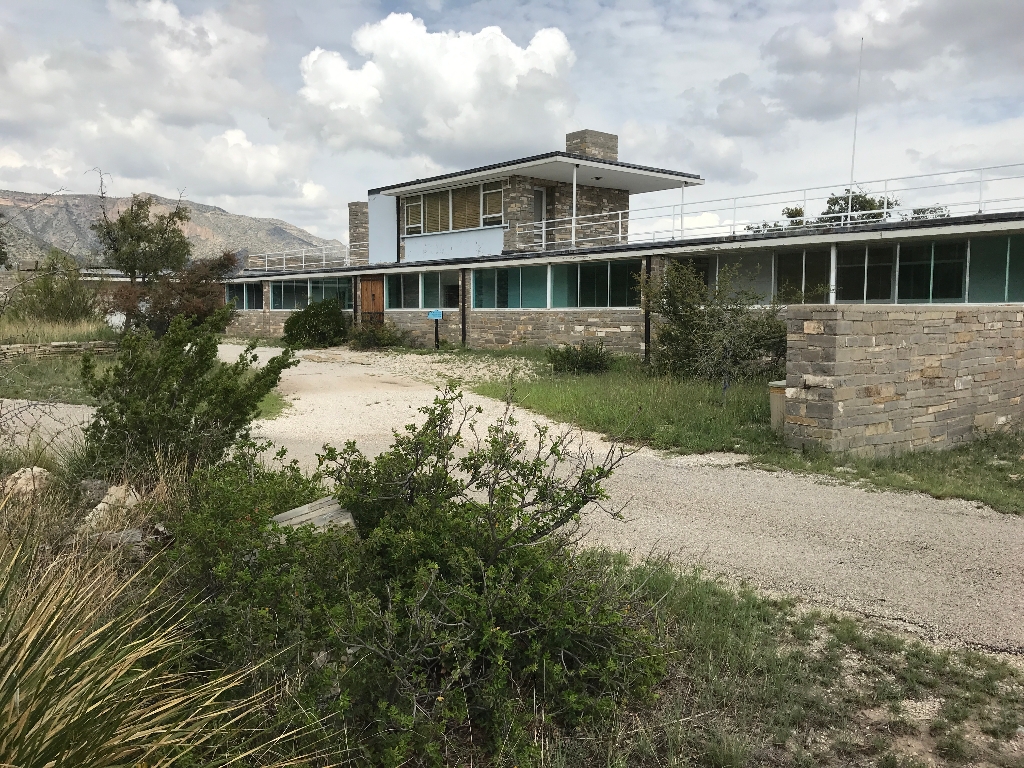
Ship on the Desert was listed as one of America’s 11 Most Endangered Historic Places by the National Trust for Historic Preservation in 2018. Stay tuned for more information about future preservation plans for the building.
Ship on the Desert is an early example of 20th century modernism, distinct for West Texas. The architecture firm Milliken & Bevin, based in New York, designed the Pratt family summer residence to blend into the surrounding mountainous landscape, using local limestone and panoramic windows which serve as the building’s most prominent character defining features.
Wallace E. Pratt first saw the land that would later become his home in 1921 when he visited West Texas on a trip with oil brokers to acquire leases for Humble. While there he was offered the opportunity to see the “most beautiful spot in Texas,” this spot being McKittrick Canyon, a resplendent enclave amid the scrub desert with free-flowing streams, waterfalls, and lush greenery. Pratt purchased the land with two partners as a summer vacation spot and built his first home in the area, Pratt Cabin, designed by architect John Staubs, in the winter of 1931-32. Pratt Cabin is a small, two bedroom cabin with a distinctly rustic feel, made of locally quarried stone. The Pratt family summered here but it’s remote location and susceptibility to inclement weather made it somewhat undesirable. After his first wife, Pearl died in 1940, he married Iris Calderhead, a prominent early 20th Century suffragist. The newlyweds quickly chose an alternate location on higher ground for their new home, and hired New York architecture firm Milliken & Bevin to design their second home.
From their time in New York City, the Pratts were close friends with Elizabeth and Newton Bevin, of the firm Milliken & Bevin. Site selection for the house occured in 1941 and primary construction began one year later. The house was completed by 1943 as per the May 1943 issue of The New Pencil Points magazine which published an article on the home. During construction, Newton Bevin and his wife Elizabeth stayed in the Pratt Cabin in McKittrick Canyon while overseeing the work of building contractor Edward Birdsall of Carlsbad, New Mexico. While the firm is formally credited for the building’s design, Pratt, in his letters, cites Elizabeth and Newton Bevin as the actual designers of the building. The built product was immediately acknowledged by the architectural community for its design excellence, with it most notably featured in New Pencil Points. Its progressive use of the stylistic and structural elements of European Modernism and the International Style were unprecedented in this remote region of West Texas. While on the one hand being an incredibly modern piece of architecture, Ship on the Desert retained, through its use of locally quarried stone masonry, a rustic quality that is very much in harmony with the landscape and with Wallace Pratt’s interests as a geologist.
The house incorporates elements of both Wallace and Iris Pratt's lives. The house was designed to resemble an oil tanker at sea, a tribute to Pratt's long career in the oil industry - at one point there was actually an oil tanker named for him. But at least one of the doors was painted a bright purple color, the color of the women's suffage movement and National Woman's Party, a likely nod to Iris's lifetime of activism for the cause of women's rights.
Following its construction, Wallace and Iris Pratt lived at the residence for the following 15 years. In their retirement, the Pratts lived in relative solitude, and Wallace would often fly his small plane from the main house to his office in Carlsbad, New Mexico. The couple eventually moved to Arizona due to health concerns, leading to Pratt’s decision to donate the house to the National Park Service in 1959. The initial donation included 4,942 acres of land and an additional 690 acres were donated by the Pratt’s between 1960 and 1961. That first gift to the NPS lead to the creation of the Guadalupe Mountains National Park, officially established in 1972. Today Ship on the Desert remains under the care of the National Park Service and is generally not open to the public.
Is there something we missed for this itinerary?
Itineraries across USA


















































